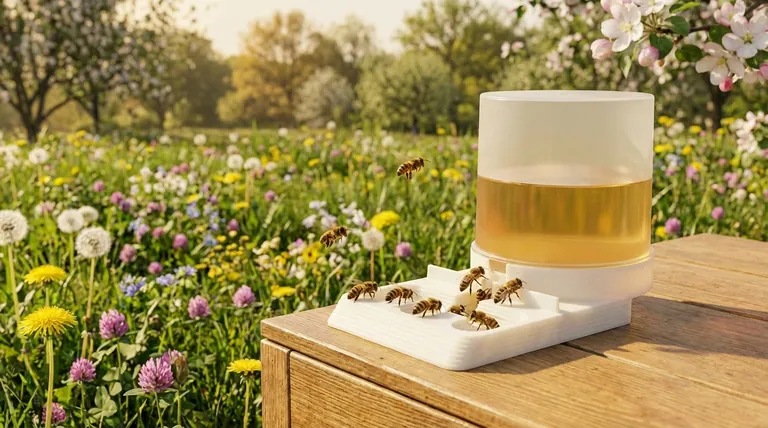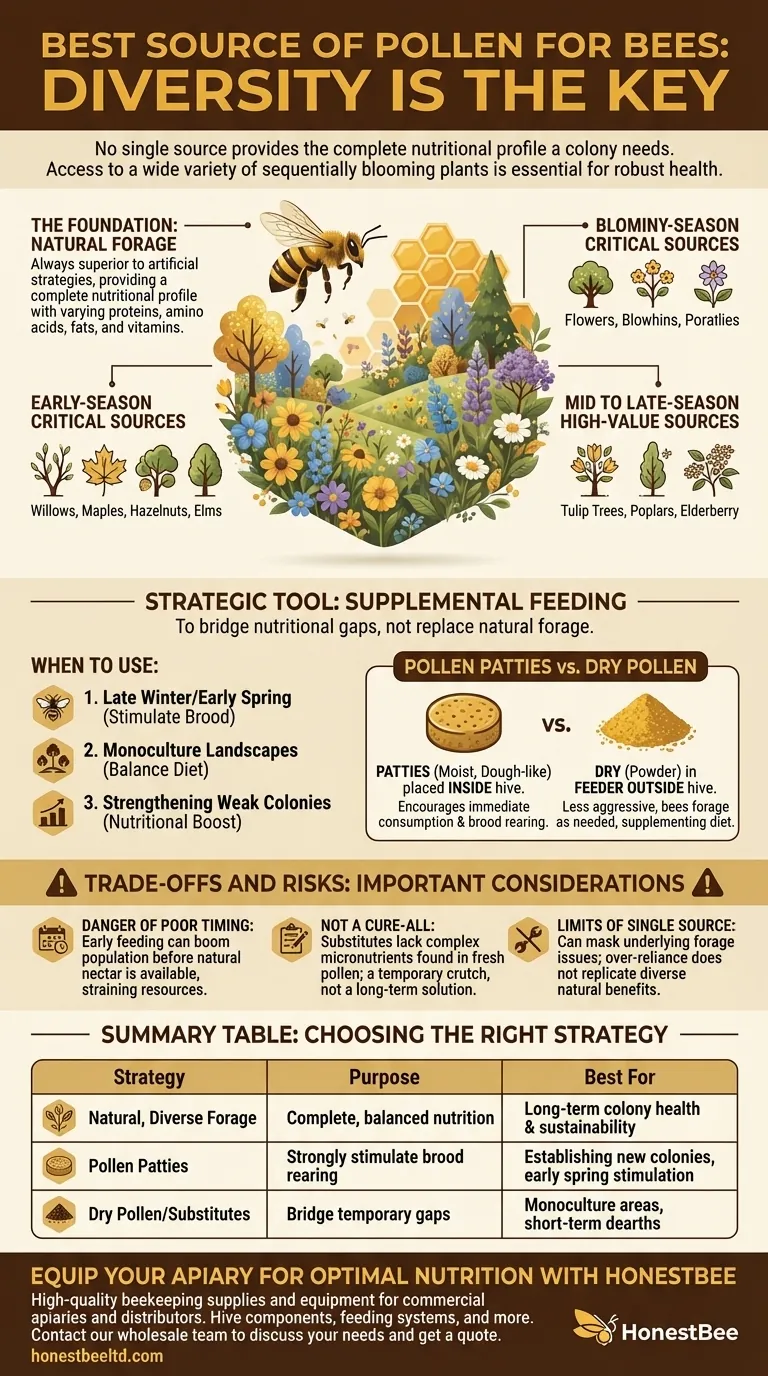The single best source of pollen for bees is diversity. While specific plants like willows and maples offer exceptionally high-quality pollen, no single source provides the complete nutritional profile a colony needs. The key to bee health is access to a wide variety of pollens from different plants that bloom sequentially throughout the foraging season.
A honey bee colony's nutritional needs cannot be met by one "superfood" plant. The optimal strategy is to ensure a continuous and varied buffet of natural pollen sources and to use man-made supplements only as a targeted intervention during periods of scarcity.

The Foundation of Bee Nutrition: Natural Forage
The most effective way to support your bees is to cultivate a landscape rich in natural, high-value pollen sources. This is always superior to any artificial feeding strategy.
Why Pollen Variety is Non-Negotiable
Different plant pollens contain varying amounts and types of essential nutrients, including proteins, amino acids, fats, and vitamins.
A monoculture diet, even from a high-quality pollen source, is like a human eating only chicken. While nutritious, it will inevitably lead to deficiencies. A diverse floral diet ensures the colony receives the complete nutritional profile required for robust health and disease resistance.
Critical Early-Season Pollen Sources
Early spring pollen is arguably the most important, as it fuels the colony's initial brood-rearing cycle and population growth after winter.
Trees and shrubs are the most significant source of this vital early nutrition. Key species include:
- Willows (Salix species)
- Maples (Acer species)
- Hazelnuts (Corylus species)
- Elms (Ulmus species)
High-Value Mid to Late-Season Sources
As spring progresses into summer, the colony's needs continue. Ensuring access to pollen during this time sustains brood rearing and prepares the colony for the winter ahead.
High-protein sources for this period include plants like Tulip Trees (Liriodendron tulipifera), Poplars (Poplus species), and Elderberry (Sambucus species).
When Nature Isn't Enough: Supplemental Feeding
Pollen supplements or feeders are a strategic tool for beekeepers, not a replacement for natural forage. Their purpose is to bridge nutritional gaps when nature cannot provide.
The Purpose of Pollen Supplements
Supplements are correctly used in three specific scenarios:
- Late winter/early spring: To stimulate brood rearing before natural pollen is available.
- Monoculture landscapes: To balance the diet where bees only have access to a single crop (e.g., almond orchards).
- Strengthening weak colonies: To provide a nutritional boost to help a struggling colony recover.
Pollen Patties vs. Dry Pollen
Supplements come in two primary forms, each with a distinct purpose.
Pollen patties are a moist, dough-like mixture of pollen or protein substitute and sugar syrup. They are placed directly inside the hive to strongly encourage immediate consumption and stimulate brood rearing.
Dry pollen or substitutes are provided in a feeder outside the hive. This method is less aggressive and allows bees to forage the powder as needed, supplementing their diet more generally.
Understanding the Trade-offs and Risks
While supplemental feeding can be beneficial, it must be done with a clear understanding of the potential downsides.
The Danger of Poor Timing
Feeding pollen patties too early in the season can create a population boom before there is adequate natural nectar and pollen to support it. This results in a large population of nurse bees with nothing to do and can strain the colony's resources.
Supplements Are Not a Cure-All
Pollen substitutes, typically made from soy flour, brewer's yeast, or other proteins, lack the complex micronutrients and beneficial compounds found in fresh, natural pollen. They are a temporary crutch, not a long-term nutritional solution.
The Limits of a Single Food Source
Even feeding a high-quality supplement cannot fully replicate the benefits of a diverse natural diet. Over-reliance on supplements can mask underlying problems with forage availability in your area, which is the more critical issue to solve.
Choosing the Right Pollen Strategy
Your approach to providing pollen should directly match your specific goal for your bees.
- If your primary focus is establishing a new colony: Provide early-season pollen patties to accelerate brood production and build a strong population quickly.
- If your primary focus is long-term, sustainable health: Prioritize planting a diverse range of pollen-rich plants that bloom sequentially from early spring through fall.
- If your primary focus is surviving a temporary pollen dearth: Use dry pollen feeders or patties as a short-term bridge to keep the colony nourished until natural forage becomes available again.
Ultimately, the best investment in your bees' nutrition is cultivating a rich and varied landscape.
Summary Table:
| Strategy | Purpose | Best For |
|---|---|---|
| Natural, Diverse Forage | Provides complete, balanced nutrition | Long-term colony health and sustainability |
| Pollen Patties | Strongly stimulate brood rearing | Establishing new colonies, early spring stimulation |
| Dry Pollen/Substitutes | Bridge temporary nutritional gaps | Monoculture areas, short-term pollen dearths |
Equip Your Apiary for Optimal Bee Nutrition with HONESTBEE
Just as a diverse pollen diet is critical for bee health, having the right equipment is essential for your success. HONESTBEE supplies high-quality beekeeping supplies and equipment to commercial apiaries and beekeeping equipment distributors through our wholesale-focused operations. We provide the tools you need to support your colonies, from hive components to feeding systems.
Let us help you build a stronger, more productive operation. Contact our wholesale team today to discuss your needs and get a quote.
Visual Guide

Related Products
- HONESTBEE Entrance Bee Feeder Professional Hive Nutrition Solution for Beekeeping
- HONESTBEE Advanced Ergonomic Stainless Steel Hive Tool for Beekeeping
- Professional Dual-End Stainless Steel Hive Tool for Beekeeping
- Professional 3-Bar Frame Grip with Integrated Hive Tool
- Beehive Handle and Frame Rest Cutting Machine: Your Specialized Hive Machine
People Also Ask
- How does the entrance feeder method work? A Guide to Simple But Risky Hive Feeding
- What is the best feeder for bees? Choose the Right Feeder for Your Hive's Success
- How to make an entrance feeder for bees? A DIY Guide for Safe & Effective Feeding
- How is the mesh ladder and barrier installed in the feeder box? A Step-by-Step Guide to Prevent Bee Drowning
- What is an entrance feeder? A Guide to Its Simple Design and High Robbing Risk



















